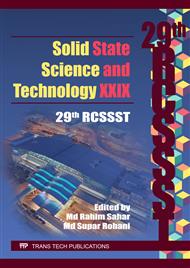[1]
Anderson, K.S., Schreck, K.M., and Hillmyer, M.A., Toughening Polylactide. Polymer Reviews, 2008. 48(1): pp.85-108.
DOI: 10.1080/15583720701834216
Google Scholar
[2]
Li, T., Turng, L-S., Gong, S., and Erlacher, K., Polylactide, nanoclay, and core–shell rubber composites. Polymer Engineering & Science, 2006. 46(10): pp.1419-1427.
DOI: 10.1002/pen.20629
Google Scholar
[3]
Yuan, Q. and Misra, R.D.K., Polymer nanocomposites: current understanding and issues. Materials Science and Technology, 2006. 22(7): pp.742-755.
DOI: 10.1179/174328406x101292
Google Scholar
[4]
Moon, S. -I., Jin, F, Lee, C-J, Tsutsumi, S., and Hyon, S-H., Novel Carbon Nanotube/Poly(L-lactic acid) Nanocomposites; Their Modulus, Thermal Stability, and Electrical Conductivity. Macromolecular Symposia, 2005. 224(1): pp.287-296.
DOI: 10.1002/masy.200550625
Google Scholar
[5]
Mat Desa, M.S.Z., Hassan, A., Arsad, A., and Mohammad, N.N.B., Mechanical properties of poly(lactic acid)/multiwalled carbon nanotubes nanocomposites. Materials Research Innovations, 2014. 18(S6): p. S6-14-S6-17.
DOI: 10.1179/1432891714z.000000000924
Google Scholar
[6]
Mat Desa, M.S.Z., Hassan, A., Arsad, A., Arjmandi, R., and Mohammad, N.N.B., Influence of rubber content on mechanical, thermal, and morphological behavior of natural rubber toughened poly (lactic acid)–multiwalled carbon nanotube nanocomposites. Journal of Applied Polymer Science, 2016. 133(48).
DOI: 10.1002/app.44344
Google Scholar
[7]
Bourbigot, S., Fontaine, G, Gallos, A., and Bellayer, S., Reactive extrusion of PLA and of PLA/carbon nanotubes nanocomposite: processing, characterization and flame retardancy. Polymers for Advanced Technologies, 2011. 22(1): pp.30-37.
DOI: 10.1002/pat.1715
Google Scholar
[8]
Villmow, T., Pötschke, P., Pegel, S., Häussler, L., and Kretzschmar, B., Influence of twin-screw extrusion conditions on the dispersion of multi-walled carbon nanotubes in a poly(lactic acid) matrix. Polymer, 2008. 49(16): pp.3500-3509.
DOI: 10.1016/j.polymer.2008.06.010
Google Scholar
[9]
Yoon, J.T., Lee, S.C., and Jeong, Y.G., Effects of grafted chain length on mechanical and electrical properties of nanocomposites containing polylactide-grafted carbon nanotubes. Composites Science and Technology, 2010. 70(5): pp.776-782.
DOI: 10.1016/j.compscitech.2010.01.011
Google Scholar
[10]
Kuan, C. -F., Kuan, H-S., Ma, C-C.M., and Chen, C-H., Mechanical and electrical properties of multi-wall carbon nanotube/poly(lactic acid) composites. Journal of Physics and Chemistry of Solids, 2008. 69(5–6): pp.1395-1398.
DOI: 10.1016/j.jpcs.2007.10.060
Google Scholar
[11]
Mina, M.F., Beg, M.D. H, Islam, M. R, Nizam, A., Alam, A.K.M.M., and Yunus, R.M., Structures and properties of injection-molded biodegradable poly(lactic acid) nanocomposites prepared with untreated and treated multiwalled carbon nanotubes. Polymer Engineering & Science, 2014. 54(2): pp.317-326.
DOI: 10.1002/pen.23564
Google Scholar
[12]
Hapuarachchi, T.D. and T. Peijs, Multiwalled carbon nanotubes and sepiolite nanoclays as flame retardants for polylactide and its natural fibre reinforced composites. Composites Part A: Applied Science and Manufacturing, 2010. 41(8): pp.954-963.
DOI: 10.1016/j.compositesa.2010.03.004
Google Scholar
[13]
Schartel, B., Pötschke, P., Knoll, U., and Abdel-Goad, M., Fire behaviour of polyamide 6/multiwall carbon nanotube nanocomposites. European Polymer Journal, 2005. 41(5): pp.1061-1070.
DOI: 10.1016/j.eurpolymj.2004.11.023
Google Scholar


